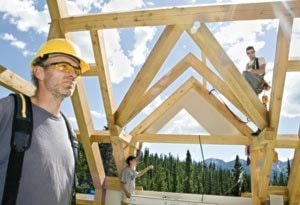Bruce Downie has wanted to build a house in the Yukon for almost 30 years.
The environmental consultant’s dream was to create something that would allow him to feel completely integrated with the territory’s natural beauty.
“I was looking for a house that reflected a natural environment kind of setting,” he said
last week.
“I wanted a natural building material that I could see and appreciate, and I also wanted something that was very bright with big spaces.”
Two years ago, the Winnipeg native bought a eight-hectare piece of land in a secluded area off Carcross Road.
“At first I thought of building a log cabin, but then I realized that it would be much too dark inside,” he said.
After months of deliberation, it was his partner, Suzanne Simard, who gave him the answer he was looking for.
“One day she said, ‘Why don’t you take a look at timber
framing?’”
Downie didn’t know what timber framing was, but a quick internet search revealed it is a building technique that employs massive wooden posts and beams that lock together like a jigsaw puzzle.
Intricate joints and wooden pegs hammered into round holes take the place of conventional nails, screws and glue.
The result is an exposed skeletal frame that supports the entire building.
It didn’t take long before Downie was “switched on” to the ages-old craft.
If you take a 10-minute drive down Lewes Lake Road south of Mount Lorne, you will see the tip of a new timber-frame roof poking above the trees.
The house is only a couple of weeks into construction, but the skeleton is already in place.
“We call it the bones,” said the architect Hans Winter from
the site.
“This is the whole bones of the house — right up to the
very peak.”
Winter works for Nordic Spirit Timberworks, a group of 12 timber-frame builders based out of Rossland, British Columbia.
In March, he and his crew spent six weeks cutting Douglas fir out of Glacier Creek in the Kootenays.
From that harvest, they milled almost 180 pieces of fir to build the home.
They then trucked it up to Downie’s site and had the frame up in less than a week.
Winter and four of his colleagues are now putting the final touches on the frame of the two-storey, 185-square-metre pad.
Douglas fir is the industry’s wood of choice, said Winter.
“They grow big and straight,” he said.
The connecting pegs are
made of oak, for strength.
Walking around the ground floor, one can’t help but marvel at the grand beams connecting up the walls and across the
ceiling.
Large open spaces have been left for oversized windows, allowing a 180-degree view of the forest and mountain landscape.
“There’s a drop-off for the billiard room so the pool table doesn’t block the view,” said Winter.
The benefits of timber framing are both its longevity and its ability to hold the entire weight of the roof, he explained.
“The skin will protect the house, but it won’t be holding up the load.”
This means the walls, free of bearing any weight, can accommodate larger windows and energy-efficient insulation.
It also lends itself to a wide-open interior.
“That way you don’t feel like you’re in a box,” said Winter.
But while there are practical reasons for timber framing, the biggest attraction is in the craftsmanship, said Winter.
“We use the structure for art,” he said.
“Probably the biggest thing
is the whole creativity that comes out of building this way.
There’s not one right way to
do it.”
Winter has 50 timber frames under his belt over 13 years of building, and each was tailor made.
“Part of the whole thing is the thought that goes into each house,” he said.
“It’s not like you’re just buying a house out of a catalogue.”
And, while more and more timber-frame builders are starting to use machines to cut their wood, his company still cuts everything by hand.
“Some people don’t care, but others like to know the wood was cut by hand.
“They like the story behind it and the imperfections.”
And once the house is finished, the owner can continue to enjoy the view of the wooden frame from the inside — top to bottom.
“It’s not cheap, but what you get for that is structural art, and you get a house that’s going to be there for hundreds of years,” he said.
There are timber-frame buildings in Germany built in the 13th century that are still standing, he added.
Nordic Spirit charges about $2,200 per square metre.
There is now a big demand for timber-frame-built housing, he said.
“When I first started working, there were two timber-frame shops near where I live,” he said.
“Now there are 10.”
There aren’t too many Yukon-based timber-frame builders, but there are a few, some of whom are currently working on the Lorne Mountain Community Centre, he said.
“Those guys are really skilled too.”
Downie spent the last six years living in Tanzania, Africa, but now he lives in a small shack on his Lewes Lake property while he waits for his new home.
He’s onsite almost every day and hopes his house will be finished by the end of August.
So far he’s really pleased with what he’s seeing.
“A natural building process is really important to me,” he said.
“The timber provides a real connection to the land that’s appropriate to the property.”
Will this be his retirement home?
“I guess you could say that,” he said with a chuckle.
“But it looks like I’ll have to work a little bit longer to pay off this thing.”
